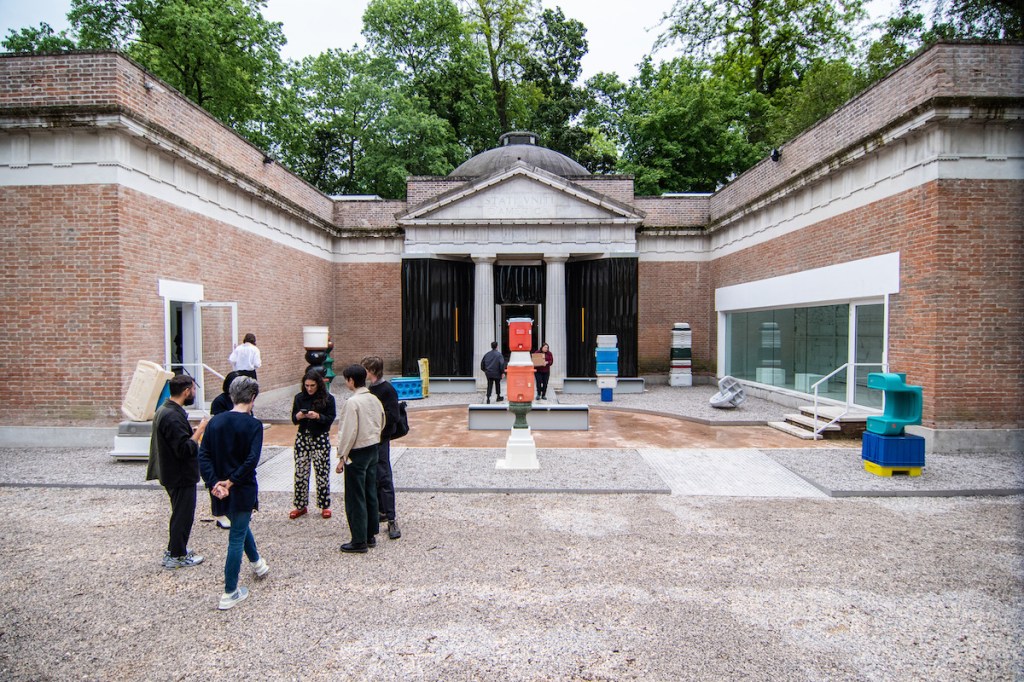According to ARTnews‘s sources, Utah-born, Mexico-based sculptor Alma Allen has been picked to represent the United States at the 2026 Venice Biennale, which is set to open next May. The pavilion’s commissioning curator is Jeffrey Uslip, according to sources, who say the official announcement cannot be made until after the government shutdown has ended.
The Baer Faxt newsletter first reported the news. It wasn’t immediately clear whether Allen and Uslip were working with a commissioning institution, as is common for the US Pavilion.
The Washington Post reported on Thursday that another pavilion proposal, by artist Robert Lazzarini, had been selected, but it was subsequently dropped by the State Department. Lazzarini attributed the decision to a bureaucratic matter rather than an ideological dispute.
Uslip is currently independent; he curated the Malta Pavilion at the 2022 Venice Biennale. In 2016, resigned from the Contemporary Art Museum St. Louis in 2016 amid a controversy over a Kelley Walker show.
ARTnews located a page on the website of the nonprofit organization American Arts Conservancy dedicated to the US Pavilion at the 2026 Biennale. Uslip is on the advisory council of the Conservancy, which “advances the legacy of American artists through preservation, education, and global cultural engagement,” according to its description.
Allen showed with the now-closed gallery Blum and Poe, and had been represented by Kasmin, which recently closed and rebranded as Olney Gleason. Allen was until listed on Olney Gleason’s aritst page as recently as last month. ARTnews has reached out to Olney Gleason for comment. Sources say he is now in talks with Perrotin gallery for representation. Perrotin did not reply to a request for comment by press time.
Born in 1970, Allen has since 2017 been based in Tepoztlán, a town just outside of Cuernavaca and south of Mexico City; prior to moving to Mexico, he was based in Joshua Tree, California. He is known for large-scale sculptures that are often made in stone, wood, and bronze.
In addition to working with traditional methods of hand-shaping and carving, Allen has also embraced new technology, including a self-built robotic device. His bronze works are fabricated at a foundry located in his studio.
“The sculptures are often in the act of doing something: They are going away, or leaving, or interacting with something invisible. Even though they seem static as objects, they are not static in my mind. In my mind they are part of a much larger universe,” Allen has previously said.
Allen is an unusual pick for the American Pavilion, as the chosen artist is often someone more high-profile than him, with a lengthier CV. Recent US representatives include blue-chip artists such as Jeffrey Gibson, Simone Leigh, Mark Bradford, Joan Jonas, and Ed Ruscha.
According to a CV last updated in May, Allen has two major institutional surveys during his three-decade career: one in 2023 at the Museo Anahuacalli in Mexico City, the other in 2018 at the Palm Springs Art Museum in California. Earlier this year, 10 of Allen’s sculptures were exhibited in New York along 20 blocks of Park Avenue. The most recent group exhibition at a museum on his CV is 2018’s “Handheld” at the Aldrich Contemporary Art Museum in Ridgefield, Connecticut. His CV also only lists five museums as owning his work, including the Palm Springs Art Museum and the Los Angeles County Museum of Art.
For each Venice Biennale, the artist is selected by Advisory Committee on International Exhibitions, which is assembled by the National Endowment for the Arts and US Department of State, via a call for proposals. Whether the American Pavilion would proceed for 2026 was questioned earlier this year as the Trump administration has made major overhauls to the federal government, including to the NEA.
Those changes have also seemingly impacted what kind of art was to be chosen for the pavilion. The call for proposals added language this year that submissions should highlight “works of art that reflect and promote American values” and that “[foster] peaceful relations between the United States and other nations,” as first reported by Vanity Fair.
Since June, artist Andres Serrano and far-right blogger Curtis Yarvin have publicly announced their proposals for the American Pavilion, though it wasn’t immediately unclear if they had actually submitted them via the application portal.
Producing the American Pavilion every two years is a costly endeavor. The US government provides a grant of only $375,000, though the exhibition often requires several million dollars for its completion. The 2024 edition by Gibson had a budget of around $5 million, while Leigh’s 2022 pavilion cost some $7 million, according to the New York Times.
Many countries have already announced their representatives for the Biennale, including Lubaina Himid for Great Britain, Yto Barrada for France, Henrike Naumann and Sung Tieu for Germany, Abbas Akhavan for Canada, and Amanda Heng for Singapore. (Countries have until January 19 to officially submit their pavilions to the Venice Biennale.)
The Australian Pavilion in particular has faced controversy. Artist Khaled Sabsabi was selected in February, but shortly after the announcement, his appointment was canceled by its commissioner Creative Australia, which led to immense outcry. Then in July, Creative Australia reinstated Sabsabi and in October gave him a $100,000 grant for an exhibition in 2027 that will feature pieces that will debut at the Biennale.



